|
Visit to NOORo I to III
the largest complex in the world
using Concentrated Solar Power (CSP) on a single site
in Ouarzazate, Morocco
as part of the SolarPACES 2018 conference,
October 6, 2018
SolarPACES 2018 Conference:
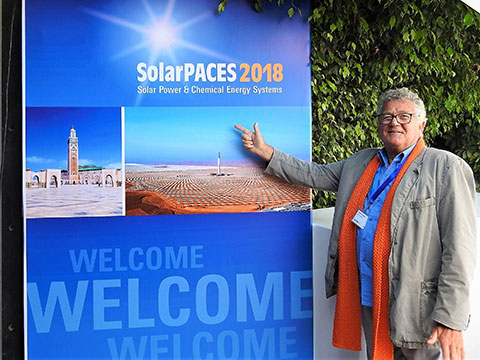
I am now again participating @ SolarPACES 2018
SolarPACES (Solar Power and Chemical Energy Systems) is holding
SolarPACES 2018 conference from October 02 - 05, 2018 in Casablanca,
Morocco.
The conference claims, (Quote): "... to again offer a scientific and
technical conference program that provides an opportunity for industry,
research, political and financing stakeholders and experts around the
world to gather and share insights into recent R&D activities and new
developments in CSP technology with a focus on development, marketing
and commercialization...." Unquote.
"My" topic: Hydrogen was only touched briefly and politely hidden under
topics as:
"Solar Fuels and Chemical commodities..."
Hydrogen had a better standing in other SolarPACES conferences in former
years, maybe the hay-days are over?
Who knows?
See here, just for comparison, the Poster, I presented @ SolarPACES 2009
in Berlin, Germany:
https://www.hydrogenambassadors.com/meet-aae/solarpaces2009/index.php
Every word on it is even more valuable today than it was than.
However, I will: "...keep patient, positive and continue to educate,
inspire and enlighten all of us ...", as Luigi Bonadio, an Energy
specialist from Melbourne, Australia commented it recently on one of my
last postings.
There will be more to come, much more ...
Impressions of the SolarPACES 2018 conference

This was in fact my 111th Conference attendance. Together with my dedicated team; we have been all over the world, to gather the latest available news on energy topics. See more
here

Networking-opportunities were great at the SolarPACES conference in 2018 in Casablanca Morocco ...

Attendees from all over the world came to learn about CSPs ...

Coffees, teas and snacks were well deserved in the brakes ...

All conference brakes were right in the exhibition area...

The main conference room was convenient located ...

This example from the Poster Presentations (out of hundreds...) shows Xiaotong Guo from the University of Nottingham, Ningbo, China
with her topic: Oxide Nanoparticles Enhanced Specific Heat Capacity of Molten Carbonate Slats for High-Temperature Solar Heat Storage (Poster Nr. S-23)
Thank you, Xiaotong, for explaining this to me ...

Face to face communication is always better, than to exchange mails or messages on the Internet.
Conferences and fairs (trade shows) are an ideal platform for that. More here

Have a closer look to this photo from the RioGlass booth. One hint: It is NOT photo-shopped or otherwise manipulated
Rioglass Solar is a global leader in designing and manufacturing optical CSP and CPV components.
I was visiting their production plant in Polígono Industrial Villallana, Lena, near Seville, Spain in the year 2017 ...

On-Sun-Testing of a 1MWt Particle Receiver with Automated Particle Mass-Flow and Temperature Control,
given by Clifford Ho from the Scandia National Laboratories, USA, was just one out of the comprehensive presentation topics on four forums. ...

Another snapshot from the presentation by Clifford Ho from the Scandia National Laboratories, USA: Sample test results for February 8, 2108 ...

My well known and well established Orange and Blue Color-Code goes well with the SolarPACES 2018 Welcome Poster.
See more here

Here the Test and Result of the On-sun Test from Miriam Ebert`s, DLR presentation on Operational Experience of a Centrifugal Particle Receiver Prototype.
The DLR Institute for Technical Thermodynamics in Stuttgart is our annual exhibitor since the Hannover Fair in 1995. See more here

The Registration Booth of the SolarPACES Organizer, PSE Conferences & Consulting GmbH, Freiburg, Germany.
I was attending SolarPACES as a Poster Presenter, See more here

Networking, networking, networking... Face to face communication can not be beaten by any other format.

The German Aerospace Center is active on solar energy since some decades. This also includes Research on Hydrogen and Fuel Cells.
See their first Participation at our first exhibition at the annul Hannover Fair in the year 1995 here

Another snapshot from Miriam Ebert`s, DLR presentation on Operational Experience of a Centrifugal Particle Receiver Prototype ...

CSP Services GmbH, Concentrating Solar Power Services, is a spin-off company of the German Aerospace Center (DLR) in Cologne, Germany,
with know-how licensed from DLR. CSPS offers engineering and consulting services for developers, operators and owners of solar thermal power plants
applying innovative and specific measurement techniques to assure high performance solar fields. See more here

In the USA, official research and development (R&D) capabilities in concentrating solar power (CSP) are done at the Scandia National Laboratory (NREL).
Their activities span the entire electricity system—from generation to transmission and distribution to the end user. See more here

Unveiling the Truth About Leakages in U-Tube Steam Generation Systems Based on TEMA Standards", was the topic of Jens Taggart Pelle, Vice President
of Technical Sales from Aalborg CSP A/S in Aalborg, Denmark.
See more here
Maybe, there are even some more things to unveil in Concentrated Solar Power, see our next chapters here...
The Masen Presentation at The NOORo Information Center, Oct 6, 2018

Founded in 2010 the Moroccan Agency for Solar Energy Masen has successfully risen to the challenge of implementing the Moroccan Noor Solar Project ...

As a single dedicated point of contact, present at each step of the value chain, Masen provides a highly efficient approach through the innovative legal and financial structuring of energy projects ...

Masen's organizational structures, a public-owned company with public capital, makes it an organization that combines the flexibility of the private sector with the strong backing of the State ...

Meeting the challenge of renewable energy development requires an appropriate legal and regulatory environment in keeping with the Kingdom’s high ambitions ...

Due to very smart contracts between the stakeholders, the actual risk of Masen is rather small and the sales of their electricity is guaranteed at current market prices ...

NOORo I needs 240 kilometers of parabolic trough collector systems with a 1.3 million total reflection area on 400 Ha (4 million sqm) to produce max. 160 MWe with a 3 h storage time ...

The NOORo I power block relies on a technology, which is well more than 100 years old. Steam drives a turbine, which in turn turns a generator. The turbine-cycle requires several hundred million cubic meters of cooling water per year ...

The photo of this solar filed (with a total length of 240 km...) at NOORo I has been taken during the construction phase, as the alignment is wrong ...

NOORo II needs 272 kilometer of parabolic trough collector system with a reflective area of 1.8 million square meter to make 220 MWe with a storage time of max. 6 hours ...

Although it is air-cooled; at NOORo II, there is still a lot of water-vapor blown into the Moroccan sky. The huge air cooled condensers reduce the water com sumption by just 80% ...

NOORo III is a concentrated solar power plant with a central tower receiver and molten salt heat storage technology, able to make 150 MWe with nightly 5 hours peak electricity storage ...

The tower has a hight of 250 meter, there are 7.400 heliostats which are manually and electronically guided, with a total reflecting area of 1.3 million square meter. Inside the receiver, molten salts are heated up to over 550 centigrade C ...
General thoughts on NOORo I to III
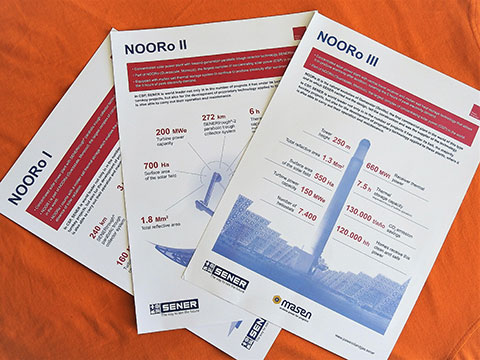
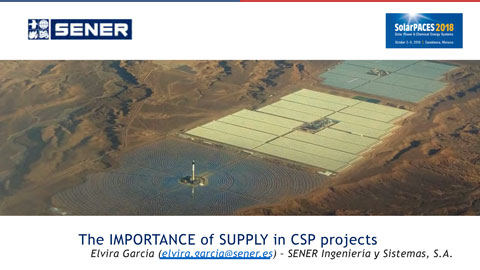
Today, I will, as a part of the SolarPACES 2018 conference, ride 460 km
on a bus to Ouarzazate Solar Power Station (OSPS), also called Noor
Power Station (ور, Arabic for light), a solar concentrated power
complex located in South Morroco.
The entire CSP Solar Project is planned to produce 580 MW at peak and is
being built in three phases and in four parts.
The total project is expected to cost $9 billion.
The plant will be able to store solar energy in the form of heated
molten salt, allowing for the production of electricity into the night.
Phase 1 comes with a full-load molten salt storage capacity of 3 hours.
Noor II, and Noor III, store energy for up to eight hours. It covers an
area of 2,500 hectares (6,178 acres).
The project is being developed with the help of the Spanish consortium
TSK-Acciona-Sener and is the first in a series of planned developments
at the Ouarzazate Solar Complex by the Moroccan Agency for Solar Energy
(MASEN).
Water consumption for the Ouarzazate Noor complex is estimated at 2.5 to
3 million m3 per year for one wet- cooling project (Noor I)
and two dry (air) – cooling projects (Noor II and III) and due to the
need to clean the reflectors regularly. Source: wikipedia
I will check it myself and let you know my findings...
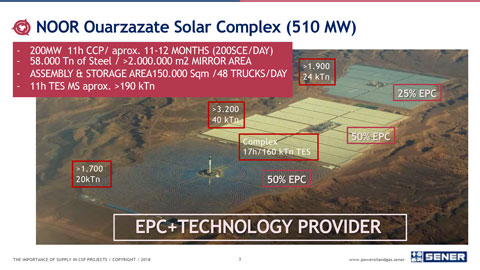
1.1 Why grid connections?
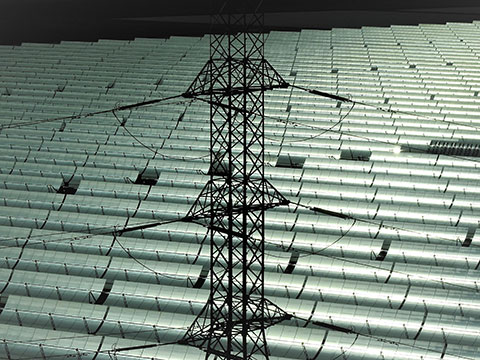
It is amazing that all renewable energies feed their electricity into
the grid.
It all started with hydropower and was then adopted uncritically for
wind energy, photovoltaic and concentrated solar energy.
Until the 1970s there were many smaller, privately and de-centrally
managed hydropower plants in Germany, which were gradually cut down by
the power plants and the network operators.
We as end-users have accepted all this uncritically and without
complaint and now we have to see how to cope with "our" disaster of
"our" energy infrastructure.
We have already paid for this infrastructure several times and continue
to pay more each day, mostly without even noticing..
The pollution and health costs are not yet priced in.
Nice for those who own and operate this infrastructure and who can live
on it more than well. Can responsible people within this system also
sleep well? I doubt that. Read my essay about those question here: https://www.hydrogenambassadors.com/background/arnos-energy-idea47.php
My original photo was taken on Oct 6, 2018, at NOORo 1 to 3 in
Ouarzazate, Morocco, the (currently) largest Concentrated Solar Energy
(CSP) complex in the world.
With just a total installed capacity of 510 MWe (turbine power
capacity). In the best case, this does not even equal half of a small
nuclear power plant.
And there are hundreds of nuclear plants, much larger than 1000 MWe ...
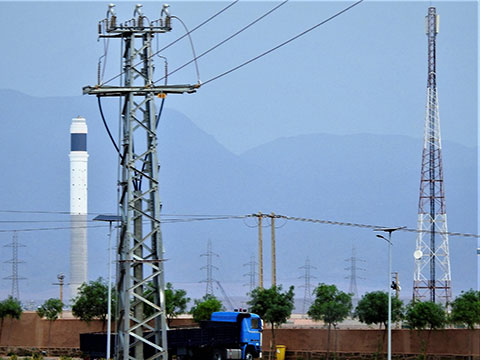
A guided tour at the NOORo I to II venue in Ouarzazate, Morocco, October 6, 2018

On just a few houses in Ouarzazate, Morocco, I could discover individual Solar Thermal Heaters on October 6, 2018.
This technolgy is known for long and still the easiest and cheapest way, to utilize solar energy for households ...

Our bus-driver had not only to watch the bends, but also for camel-crossing ...

It is amazing, that all renewable energies feed their electricity into the archaic grid.
It all started with hydropower and was then adopted uncritically for wind energy, photovoltaic and concentrated solar energy ...

The NOORo (ور, Arabic for light) Ouarzazate, Morocco site was the biggest Concentrated Solar Power CSP complex of the world at my visit October 6, 2018 ...

Security measures at the Main Gate were tight, but we had been expected, with a total bus load of for buses full of CSP experts ...

Our Passport-Numbers all had been per-registered with the organizer of the SolarPACES conference, so we could pass without any problems ...

The construction sign for the NOORo complex with the main contractors involved. In the background the huge heat exchangers from NOORo I ...

A cleaning robot for the 240-kilometer SENERtrough (R) parabolic trough collector system ...

The water inlet for cooling the Steam Turbine in NOORo I. It is located at the Barrage El Mansour Eddahbi reservoir in a distance of around 6 kilometer (4 miles)
There was an existing Hydroelectric Power Plant with an installed capacity of 10 MW. More here ...: http://globalenergyobservatory.org/geoid/41650

The two tubes contain the heated fluids from the solar SENERtrough(R) collectors (left). This fluid, generically called HTF (Heat Transfer Fluid), is similar to oil in its composition ...

The electricity that is generated here must be fed into the Moroccan electricity grid. There would also be other uses conceivable ...

General overlook on NOORo II from the Masen Center observatory tower ...
NOORo I
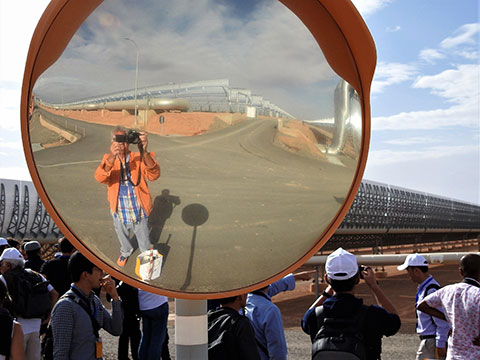
My thoughts on renewable energy, here: NOORo I in Ouarzazate, Morocco
October 6, 2018, I had the unique opportunity, together with four
busloads of participants in the SolarPACES 2018 conference in
Casablanca, Morocco, to visit today`s world's largest Concentrated Solar
Power CSP Complex as part of the Technical Tour.
Let's start, after checking out my general considerations:
https://lnkd.in/gRRjx6y
NOORo I first:
400 Ha = 4.000.000 = 4 Mio M² Surface area of the solar field
1.3 Mio M² Total reflective area
240 km SENERtrough(R) parabolic trough collector system
160 MWe Turbine power capacity, connected to the Marocain electricity
grid, with all its following losses. In transforming up/down.
The effective Thermal storage capacity of NOORo I claimed to be 3 hours
(equivalent hours of turbine operation).
The amount of fresh water needed, to cool the turbine cycle is not
prominently mentioned. I will find it out. Addition water for cleaning
the surfaces of the troughs is needed, too.
All in all a heat/turbine/generator technology, 130 years old and which
did not change much from its introduction by people like Edison,
Westinghouse, Tesla, and Siemens.
Sources: SENER (The way to see the future) and: masen (endless power for
progress)
Photo: Self.
Arno's personal impressions from NOORo I

NOORo I is a concentrated solar power plant with a 240 kilometer long parabolic SENERtrough(R) collector technology with 400 Ha Surface area of the solar field ...

The assembly in the middle is conventional. The Turbine has a power capacity of 160 MWe to feed the Electric Generator, to feed the Moroccan grid ...

Masen, the owner and operators of the plant, claims to clean the 1.3 Million square meter total reflective area once a month ...

Solar radiation beams on the SENERtrough(R) which concentrates the radiation in the central tube through which fluid is heated to very high temperatures ...

The fluid in the central tubes is called HTF (Heat Transfer Fluid) is in this case similar to oil in it`s composition ...

The HTF is pumped through the solar fields, where it is heated by the sun radiation ...

The international attendees of the SolarPACES 2018 conference were quite interested, to come so close to the 240 km collectors at NOORo I

The main complex of NOORo I looks like heavy machinery and that is, what it is: A 130 years old technology ...

Heavy insulated piping is needed, to grant a reasonable efficiency of the power plant ...

Even at places like this, selfies are possible during a guided tour as part of SolarPACES 2019 ...

Immense temperatures inside the central tubes have to be captured and pumped through 240 kilometer ...

The water cooling of the turbine cycle needs a lot of cooling water, which has to be pumped here from a reservoir at a distance of around 6 kilometer ...
NOORo II
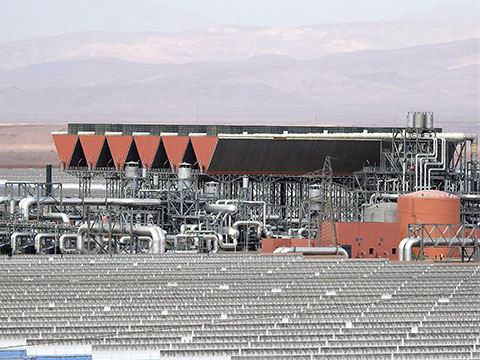
I hereby continue my coverage of our visit October 6, 2018, to NOORo I
to III in Ouarzazate, Morroco
as part of the SolarPACES 2018 conference. Let's come to NOORo II:
Here are some key figures:
272 km SENERtrough(R)-2 parabolic trough collector system ...
700 Ha = 7.000.000 m² Surface area of the solar field ...
1.8 Mio sqm total reflecting area ...
200 MWe Turbine power capacity ...
6 h Thermal storage capacity (equivalent hours of turbine operation) ...
What looks like at my original, on-site photo as heavy machinery, is in
fact heavy machinery:
A partial view of the immense air cooling system for the turbine cycle
needed due to the laws of thermodynamics...
An association with Renewable Energies is rather remote and hard to
understand
NOORo II Gallery

Also Renewable energies have to follow the laws of thermodynamics. Partial view of the air cooled condenser; with Chinese subcontractors ...

Yes, it is quite conventional how the steam in the turbine cycle has to be cooled here ...

The huge air cooled condensers have the size of a BIG apartment house with hundredths of flats ...

Only from close, the conventional technology, about 130 years old, can be discovered ...
NOORo III:
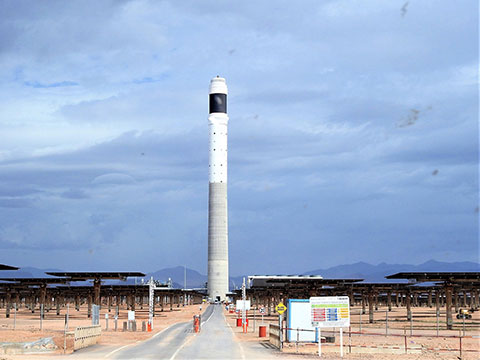
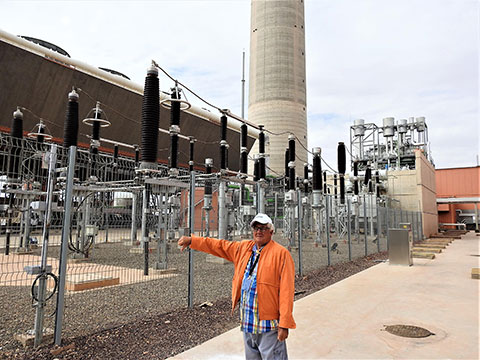
Hereby let us continue my coverage of our visit October 6, 2018,
to NOORo I to III in Ouarzazate, Morocco as part of the SolarPACES 2018
conference.
Let's come to NOORo III, a Concentrated Solar Power pant (CSP) with a
central tower receiver and molten salt heat storage technology, allowing
a 5 hours reserve to make electricity after sunset.
Here are some key figures:
Tower height: 250 meter
Total reflecting area: 1.3 Million square meter (sqm)
Surface area of the Solar fields: 550 Ha = 5.500.000 sqm
Number of Heliostat: 7.400
Receiver thermal power: 660 MWt
Turbine power capacity: 150 MWe
Thermal storage capacity: 7.5 hours (equivalent hours of turbine operation)
NOORo III is the development of Gemasolar in Seville, Spain, which I
also visited, alongside another CSP conference.
NOORo III Gallery

I always wonder, why electricity, gained by REs is today always connected to a grid ...

The tower has a hight of 250 meter ...

Inside this receiver on top of the tower, molten salts are heated up to over 550 degrees C before being stored in the hot molten salt tank ...

It was my great pleasure, to have the opportunity to see NOORo I to II from so close ...

Without substations, nothing is working, even with renewable energies. This transformer leads to the Moroccan grid ...

Chinese subcontractors are very active on-site, here at the huge air cooling system for the turbine cycle ...

The international attendees of the SolarPACES conference took their selfies here under the shadows of the 7.400 heliostats ...

Each of the 7.400 heliostats has the size of around 100 square meter, the total reflective area is 1.3 million square meter ...

The total surface area of the NOORo III solar field is 550 Ha, that equals 5.500.000 square meter ...

The electrical turbine in the middle of the field has a modest capacity of just max. 150 Mwe ...

Also to really in use at my visit , The heliostats make a very old and attacked impression ...

The 7.400 heliostats have to be steered precisely, to capture the sunlight into the center of the receiver on top of the tower ...
Morocco turns the Sahara desert into a solar energy oasis
Source: PBS NewsHour
The PBS NewsHour is an American daily evening television news program that is broadcast on the Public Broadcasting Service (PBS), airing seven nights a week on more than 350 of the public broadcaster's member stations. As the nation's first hour-long nightly news broadcast, the program is known for its in-depth coverage of issues and current events. ...The PBS NewsHour originates from WETA's studio facilities in Arlington County, Virginia (for its weekday editions), and the Tisch/WNET Studios at Lincoln Center in Manhattan (for its weekend editions); additional facilities are located in San Francisco and Denver. The program is a collaboration between WETA-TV, WNET, and fellow PBS member stations KQED in San Francisco, KETC in St. Louis and WTTW in Chicago, USA.
Back from Ouarzazate to Casablanca, 450 km in 9 hours

Back from Ouarzazate to Casablanca, 450 km in 9 hours

Back from Ouarzazate to Casablanca, 450 km in 9 hours

Back from Ouarzazate to Casablanca, 450 km in 9 hours

Back from Ouarzazate to Casablanca, 450 km in 9 hours

Back from Ouarzazate to Casablanca, 450 km in 9 hours

Back from Ouarzazate to Casablanca, 450 km in 9 hours

Back from Ouarzazate to Casablanca, 450 km in 9 hours

Back from Ouarzazate to Casablanca, 450 km in 9 hours

Back from Ouarzazate to Casablanca, 450 km in 9 hours

Back from Ouarzazate to Casablanca, 450 km in 9 hours

Back from Ouarzazate to Casablanca, 450 km in 9 hours

Back from Ouarzazate to Casablanca, 450 km in 9 hours

Back from Ouarzazate to Casablanca, 450 km in 9 hours

Back from Ouarzazate to Casablanca, 450 km in 9 hours

Back from Ouarzazate to Casablanca, 450 km in 9 hours

Back from Ouarzazate to Casablanca, 450 km in 9 hours

Back from Ouarzazate to Casablanca, 450 km in 9 hours

Back from Ouarzazate to Casablanca, 450 km in 9 hours

Back from Ouarzazate to Casablanca, 450 km in 9 hours

Back from Ouarzazate to Casablanca, 450 km in 9 hours
|
|







































































































